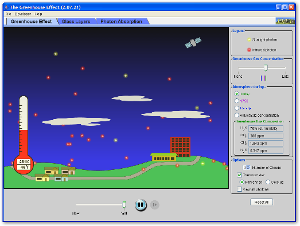PhET Greenhouse Effect Lab
For this lab, use the Greenhouse Effect PhET simulation to guide your understanding of how the greenhouse effect and light absorption work.
How do greenhouse gases affect the climate? Explore the atmosphere during the ice age and today. What happens when you add clouds? Change the greenhouse gas concentration and see how the temperature changes. Then compare to the effect of glass panes. Zoom in and see how light interacts with molecules. Do all atmospheric gases contribute to the greenhouse effect?
http://phet.colorado.edu/en/simulation/greenhouse
Greenhouse Effect: Click on the “Greenhouse Effect” tab at the top of the screen. The thermometer represents the average global temperature.
- What do the yellow dots moving down represent?
- What do the red dots represent?
- Watch them carefully. Do they all move upwards? Why or why not?
- Which rays does the Earth release after turning the rays from the sun into heat energy?
- Infrared rays
- Both
- Ultraviolet rays
- Neither
- Which greenhouse gases does the simulation consider?
- Which time period do the default conditions represent?
- What is the average global temperature for the “today” simulation?
- Is the behavior of the photons more similar to the greenhouse simulation with or without glass panes?
- Reduce the greenhouse gas concentration to “None”.
- What is happening with the photons?
- What is the average global temperature?
- Considering the behavior of the photons, why does the temperature drop so much?
- Increase the greenhouse gas concentration to “Lots.”
- What is the average global temperature?
- Considering the behavior of the photons, why does the temperature increase?
Extra Credit: Experiment with other periods in earth’s history or add clouds and record your observations.
Photon Absorption: Click on the “Photon Absorption” tab at the top of the screen. A methane molecule sits in the middle of the screen. Use the slider on the left side of the screen to shoot some infrared photons at the molecule.
- Do all the photons pass through the molecule?
- When a photon gets absorbed, what happens next?
- When a new photon is emitted, is it always sent in the same direction?
Use the buttons on the right side of the screen to test different molecules. Record your observations in the table below.
4. Which gases absorb photons?
|
Infrared Photons |
Visible Photons |
|
| CH4 (methane) | ||
| CO2 (carbon dioxide) | ||
| H2O (water vapor) | ||
| N2 (nitrogen) | ||
| O2 (oxygen) |
Using the table above:
5. Which gases contribute to the greenhouse effect in our atmosphere?
6. Which gases do NOT contribute to the greenhouse effect?
EXTRA CREDIT Answer the following questions:
- Your family’s car has been parked outside on a cold but sunny day. When you get in the car, it is much warmer than the air outside. Explain how this can happen.
- How is the “greenhouse effect” similar to blankets on a bed?
